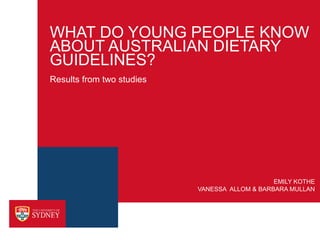
Kothe - ASBHM - What do young people know
- 1. WHAT DO YOUNG PEOPLE KNOW ABOUT AUSTRALIAN DIETARY GUIDELINES? Results from two studies EMILY KOTHE VANESSA ALLOM & BARBARA MULLAN
- 2. BACKGROUND › Australian dietary guidelines recommend that adults consume two servings of fruit and five servings of vegetables each day. › This recommendation has been widely promoted in the Australian community through the Go for 2&5 social marketing campaign. › Young Australians (19-24 years) are less likely than any other age group to consume adequate amounts of fruit and vegetables. 2
- 3. UNDERSTANDING CONSUMPTION STUDY ONE › AIM: - To investigate the specific factors relevant to healthy eating behaviours in Australian young adults using a qualitative design. › DESIGN: - 45 young adults participated in focus group discussions about fruit and vegetables. - Discussions lasted 1-2 hours and involved 5-7 participants. - All focus groups were transcribed verbatim and analysed using framework analysis. 3
- 4. UNDERSTANDING CONSUMPTION STUDY ONE › RESULTS: - Analysis identified a number of barriers to consumption that fell into the a priori coding frame. - Significant knowledge gaps and misunderstandings were also identified. - Participants reported feeling confused about dietary guidelines - Many groups could not correctly report dietary guidelines - Many participants were unsure what foods contributed to dietary guidelines - Participants repeatedly made comments that appeared reveal significant knowledge gaps relating to serving sizes 4
- 5. UNDERSTANDING CONSUMPTION STUDY ONE › CONCLUSION: - Most fruit and vegetable promotion campaigns assume that people have a certain level of knowledge about fruits and vegetables. - Young people may not know enough to understand - and adhere to - dietary guidelines 5
- 6. QUANTIFYING KNOWLEDGE GAPS STUDY TWO › AIM: - To quantitatively investigate the fruit and vegetable related knowledge of a sample of Australian young people. › DESIGN: - One-hundred and six young adults (mean age = 19 years) completed a web- based questionnaire that assessed recall and understanding of Australian dietary guidelines for fruit and vegetable consumption. - Recall of the guidelines, serving size knowledge, and food knowledge were all assessed. 6
- 7. QUANTIFYING KNOWLEDGE GAPS STUDY TWO › RESULTS: - Knowledge of Australian dietary recommendations was assessed using both unprompted and prompted methods. - Unprompted recall: - 43% of individuals correctly reported the RDI of fruit - 54% of individuals correctly reported the RDI of vegetables. - Prompted recall: - 48% of individuals correctly reported the RDI of fruit - 64% of individuals correctly reported the RDI of vegetables. - Only 9% of participants correctly reported the Australia dietary guidelines for both fruit and vegetable consumption. 7
- 8. QUANTIFYING KNOWLEDGE GAPS STUDY TWO › RESULTS: - Serving size knowledge was assessed using a serving size approximation task. Participants were asked to report the serving size for two fruits and two vegetables (apple, grapes, carrot and lettuce) Correct Incorrect Don’t Know Apple 61 34 0 Grapes 41 47 0 Carrot 30 57 4 Lettuce 30 38 4 8
- 9. QUANTIFYING KNOWLEDGE GAPS STUDY TWO › RESULTS: - Food Product Knowledge was assessed using a recipe task. Participants were provided with a recipe and asked to indicate which foods would contribute to their daily intake of fruit and vegetables. % of participants who correctly classified the ingredient Carrot 97 Celery 96 Potato 90 Turnip 86 Canned tomato 78 Onion 71 Tomato paste 23 9
- 10. QUANTIFYING KNOWLEDGE GAPS STUDY TWO › CONCLUSIONS: - Young adults in study two appeared to have significant gaps in all three domains of fruit and vegetable related knowledge. - Only a small minority of individuals could report both the fruit and vegetable guidelines - Many participants could not accurately report serving sizes or correctly identify foods which contribute to their daily intake of fruit and vegetables. - Knowledge gaps were consistent with knowledge gaps and misconceptions revealed in study one. These knowledge gaps show the need for a fresh approach to fruit and vegetable promotion in this population. 10
- 11. THANK YOU 11